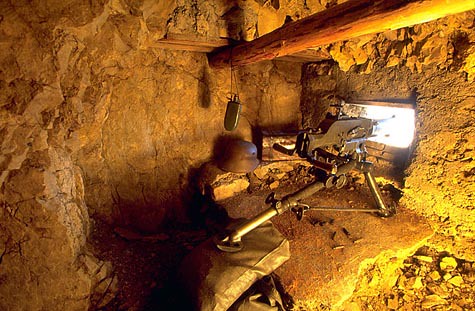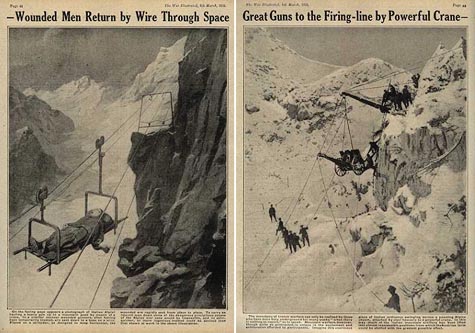 [Image: At the self-interconnected heights of Aiguille du Midi, France (via)].
[Image: At the self-interconnected heights of Aiguille du Midi, France (via)].On a purely superficial level, the above photograph of some Alpine resort in France reminded me of two comments left long ago on BLDGBLOG by a reader named Andy K.
Andy, responding to an old post called "Europe's Geological Attics," pointed out that "[t]he peaks of the Dolomites in Italy are full of bunkers and tunnels of various depths. They come from the bitter fighting that took place over the South Tyrol region in WWI."
These "bunkers and tunnels of various depth" were, for the most part, constructed by and for the Alpini, Italy's mountain warfare brigade, to aid in Italy's war against the Austrians.
 [Image: The fortified peaks of the Rotwand Summit, WWI].
[Image: The fortified peaks of the Rotwand Summit, WWI].Today there are even some hiking trails – called the vie ferrate – that will take you up to these now abandoned structures embedded in the uplifted rocky surface of the earth, should you be willing and able to hike that far.
 [Image: Found via, copyrighted to, and courtesy of Dolomiti.org].
[Image: Found via, copyrighted to, and courtesy of Dolomiti.org].Limiting ourselves for the time being to Wikipedia, we learn that:
- Until the end of 1917 the Austrians and the Italians fought a ferocious war in the mountains of the Dolomites; not only against each other but also against the hostile conditions. In the particularly cold winter of 1916 thousands of troops died of cold, falls or avalanches. At least 60,000 troops died in avalanches during the war. Both sides tried to gain control of the peaks to site observation posts and field guns. To help troops to move about at high altitude in very difficult conditions permanent lines were fixed to rock faces and ladders were installed so that troops could ascend steep faces. These were the first via ferrata.
 [Image: A machine gun nest embedded in the Italian mountainside; found via, copyrighted to, and courtesy of Dolomiti.org].
[Image: A machine gun nest embedded in the Italian mountainside; found via, copyrighted to, and courtesy of Dolomiti.org].Of course, evacuating the wounded was also rather interesting; I was fascinated to see that "wounded men return by wire through space."
 [Images: Wounded men returning by wire through space as cannons are raised into place by cranes; via].
[Images: Wounded men returning by wire through space as cannons are raised into place by cranes; via].Awesomely, sci fi author and war correspondent H.G. Wells even did some reporting on the matter.
For The New York Times, back in 1916, Wells wrote:
- Mountain surfaces are extraordinarily various and subtle. You may understand Picardy upon a map, but mountain warfare is three-dimensional. A struggle may go on for weeks or months consisting of apparently separate and incidental skirmishes, and then suddenly a whole valley organization may crumble away in retreat or disaster.
 [Image: Found via, copyrighted to, and courtesy of Dolomiti.org].
[Image: Found via, copyrighted to, and courtesy of Dolomiti.org].– in fact, he adds, the "fighting in the Dolomites has been perhaps the most wonderful of all these mountain campaigns" – Wells goes on:
- Everywhere it has been necessary to make roads where hitherto there have been only mule tracks or no tracks at all; the roads are often still in the making, and the automobile of the war tourist skirts precipices and takes hairpin bends upon tracks of loose metal not an inch too broad for the operation, or it floats for a moment over a dizzy edge while a train of mule transport blunders by. (...) Down below, the trees that one sees through a wisp of cloud look far too small and spiky and scattered to hold out much hope for a fallen man of letters. And at the high positions they are too used to the vertical life to understand the secret feelings of the visitor from the horizontal.
- The aspect of these mountains is particularly grim and wicked; they are worn old mountains, they tower overhead in enormous vertical cliffs of sallow gray, with the square jointings and occasional clefts and gullies, their summits are toothed and jagged; the path ascends and passes around the side of the mountain upon loose screes, which descend steeply to a lower wall of precipices. In the distance rise other harsh and desolate-looking mountain masses, with shining occasional scars of old snow. Far below is a bleak valley of stunted pine trees, through which passes the road of the Dolomites.
 [Image: From The New York Times; I've also uploaded a much larger, readable version: click here to see it].
[Image: From The New York Times; I've also uploaded a much larger, readable version: click here to see it].In any case, it's the idea of the Alps being riddled with manmade caves and passages, with bunkers and tunnels, bristling with military architecture – even self-connected peak to peak by fortified bridges, the Great Mountain Wall of Northern Italy, architecture literally become mountainous, piled higher and higher upon itself forming new artificial peaks looking down on the fields and cities of Europe – that just fascinates me; not to mention the idea that you could travel up, and thus go futher into history, discovering that the past has been buried above you, the geography of time topologically inverted.
(Thanks, Andy K!)
No comments:
Post a Comment